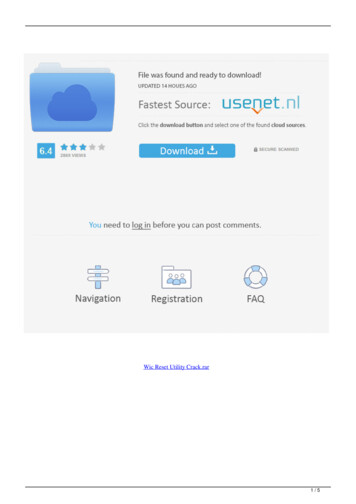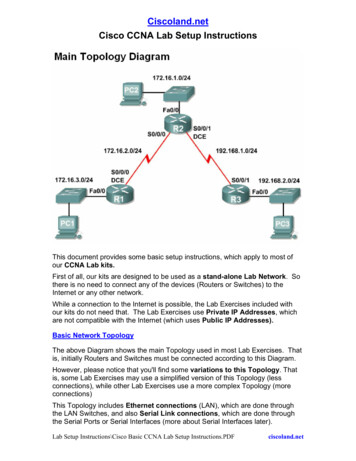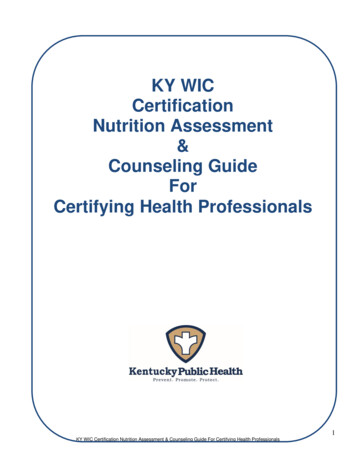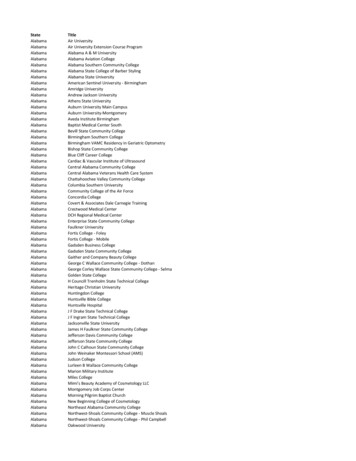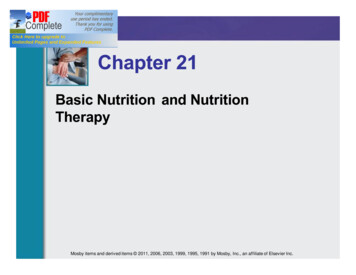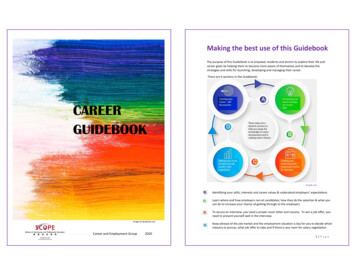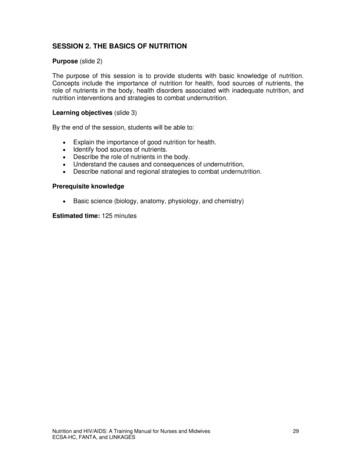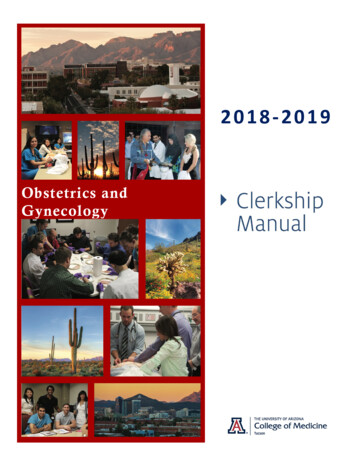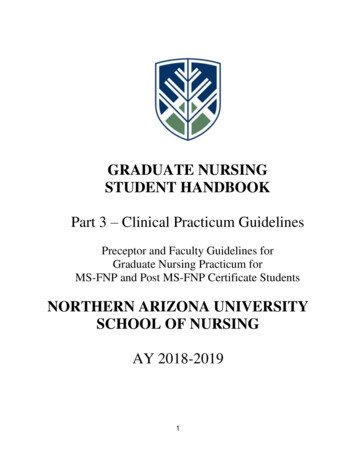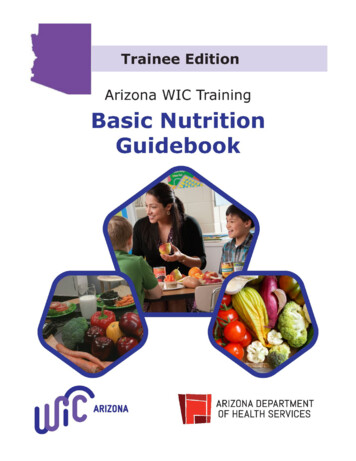
Transcription
Basic Nutrition GuidebookBureau of Nutrition and Physical ActivityPage 1Arizona WIC TrainingTrainee Edition11/16/2020
Basic Nutrition GuidebookArizona WIC TrainingTrainee EditionContentsContents . 2What Will You Learn?. 3Items Needed for This Course. 3Recommended Time . 3Things to Remember . 3Basic Nutrition Course Instructions . 4Module 1: Introduction to Nutrition . 5Module 1: Activity 1 . 5Module 2: Macronutrients and Micronutrients . 6Module 2: Activity 1 . 6Module 2: Activity 2 . 7Module 2: Activity 3 . 8Module 2: Activity 4 . 9Module 2: Activity 5 . 9Module 2: Activity 6 . 11Module 2: Activity 7 . 12Module 2: Activity 8 . 13Module 3: Healthy Eating Recommendations . 14Module 3: Activity 1 . 14Module 3: Activity 2 . 15Module 3: Activity 3 . 15Module 3: Activity 4 . 16Module 3: Activity 5 . 16Module 3: Activity 6 . 17Module 3: Activity 7 . 18Module 3: Activity 8 . 19Bureau of Nutrition and Physical ActivityPage 211/16/2020
Basic Nutrition GuidebookArizona WIC TrainingTrainee EditionWhat Will You Learn?Understanding nutrition is a powerful way for you make a difference in WIC participants’ lives. You willlearn to help WIC participants make choices to improve their nutrition and health.After completing the Basic Nutrition LMS Course and guidebook, you will be able to: Identify food sources of saturated, polyunsaturated, monounsaturated, and trans fats Identify protein sources Identify high-fiber carbohydrate sources List food sources of vitamin A, vitamin C, folic acid, calcium, and iron Read a food label and be able to communicate what is identified Provide dietary recommendations to participants with more restrictive diets, includingvegetariansItems Needed for This Course Pen or pencilAccess to Basic Nutrition LMS CourseLocal Agency Referral ListAccess to the website: www.choosemyplate.govRecommended Time Approximate time it takes to complete the Basic Nutrition LMS course: Two to three hoursApproximate time it takes to complete this Basic Nutrition Guidebook and discussion with yourtrainer: One to two hoursThings to Remember This guidebook is yours to keep.You are encouraged to take notes, highlight, and write in this guidebook.As your trainer chooses, you may work in a group or as an individual.You are encouraged to ask your trainer(s) for help, ask questions about the information in thecourse, or ask any questions about additional topics related to Basic Nutrition training.Bureau of Nutrition and Physical ActivityPage 311/16/2020
Basic Nutrition GuidebookArizona WIC TrainingTrainee EditionBasic Nutrition Course Instructions Log onto https://www.train.org/arizona/home Open and complete the Basic Nutrition LMS Course module and the corresponding BasicNutrition Activities in this guidebook. At your trainer’s direction, complete the Basic Nutrition LMS Course and guidebook, eitherindividually, with other trainees, or with your trainer. Complete the Basic Nutrition Post-Test. Meet with your trainer at their direction to discuss each module of the Basic Nutrition LMSCourse and the associated activities in this guidebook, either after each module, or after allmodules have been completed.Bureau of Nutrition and Physical ActivityPage 411/16/2020
Basic Nutrition GuidebookArizona WIC TrainingTrainee EditionModule 1: Introduction to NutritionMODULE 1 COMPETENCIES:1. Trainees will be able to describe digestion, absorption, and metabolism in their own words.2. Trainees will be able to identify the defining characteristics of each of the six categories ofnutrients.Module 1: Activity 11. In the table below, describe each term (Metabolism, Digestion, and Absorption) in your ownwords.TermsDescribe each term in your own words:DigestionAbsorptionMetabolismDigestionBureau of Nutrition and Physical ActivityAbsorptionPage 5Metabolism11/16/2020
Basic Nutrition GuidebookArizona WIC TrainingTrainee EditionModule 2: Macronutrients and MicronutrientsMODULE 2 COMPETENCIES:1. Trainees will familiar with the health benefits of fiber and be able to provide recommendationsto participant to help increase their intake of fiber.2. Trainees will be able to explain what empty calories are, and discuss healthy options withparticipants to reduce their “empty calorie” consumption.3. Trainees will be able to familiar with “good” and “bad fats and be able to substitute foods thatare high in saturated and trans fats with foods high in polyunsaturated and monounsaturatedfats.4. Trainees will be able to recommend food sources that are high in vitamin A, vitamin C, iron, andfolic acid to participants.5. Trainees will be able to describe the relationship between calcium and iron absorption andrecommend good food sources of each to participants.6. Trainees will be familiar with the benefits of water and be able to provide recommendations toreduce the risk of dehydration for at-risk populations.Module 2: Activity 1Directions:Answer the following questions.1. What are some of the health benefits of consuming a diet high in fiber?2. Discuss the differences between soluble and insoluble fiber and include examples of each.3. Provide three tips you could share with a participant about how to increase their fiber intake.Bureau of Nutrition and Physical ActivityPage 611/16/2020
Basic Nutrition GuidebookArizona WIC TrainingTrainee EditionModule 2: Activity 2Directions:Answer the following questions.1. Imagine that a participant says to you, “I’ve always thought that it was bad to eat fat, but latelyI’ve been hearing more and more about ‘good fats’ and ‘bad fats’. I still don’t know what thedifference is though.” How would you respond?2. What recommendations would you provide to this participant to reduce their consumption of“bad” fats?Bureau of Nutrition and Physical ActivityPage 711/16/2020
Basic Nutrition GuidebookArizona WIC TrainingTrainee EditionModule 2: Activity 3Directions:Review each type of food that is high in saturated or trans fats (“Unhealthy Fat Choices”), then completethe chart by thinking of a healthier substitute or alternative preparation method for each type ofunhealthy fat choice to contain more monounsaturated or polyunsaturated fats (“Healthier FatSubstitutes”) that you could suggest to a participant, keeping in mind their cultural practices.Unhealthy Fat ChoicesHealthier Fat SubstituteTortillas made with lardFatty beef and pork cutsFrozen biscuits made withhydrogenated shorteningMilk chocolate candiesDeep-fried chickenBureau of Nutrition and Physical ActivityPage 811/16/2020
Basic Nutrition GuidebookArizona WIC TrainingTrainee EditionModule 2: Activity 4Directions:Answer the following question.1. Additional protein is required during periods of rapid growth, such as pregnancy, infancy, andchildhood. What are some examples of foods you might recommend to participants to ensurethey are getting enough protein in their diet regularly?Module 2: Activity 5Directions:Use the table below, in addition to the information you learned from the Basic Nutrition LMS Course, toanswer the following questions.Vitamin AOrange/red vegetablesCarrotYamBell pepperSweet potatoWinter squashVegetable juice, cannedDark green gusRomaine lettuceArtichokeVitamin AOrange heeseProteinEggLiver (beef/lamb)Fish (salmon, tuna,mackerel)Bureau of Nutrition and Physical ActivityVitamin CFruitsOrangeGrapefruitLemonBell toVegetablesBroccoliCabbageSnow peaKalePage 9Folate / Folic AcidBeans/Nuts/SeedsLentilsEdamamePinto beansGarbanzo beansBlack beansPeanutsSunflower seedsFruitsAvocadoPapayaOrange juiceEnriched GrainsPastaBread11/16/2020
Basic Nutrition GuidebookArizona WIC TrainingTrainee Edition1. What ideas would you offer to a participant to improve their dietary intake of vitamin A?2. What ideas would you offer to a participant to improve their dietary intake of vitamin C?3. How would you explain to a participant some of the most important functions of folic acid inthe body?4. What ideas would you offer to a participant to improve their dietary intake of folic acid?Bureau of Nutrition and Physical ActivityPage 1011/16/2020
Basic Nutrition GuidebookArizona WIC TrainingTrainee EditionModule 2: Activity 6Directions:Answer the following questions.1. How would you explain to a participant some of the most important functions of iron?2. What ideas would you offer to a participant to improve their dietary intake of iron?3. What is the relationship between calcium intake and iron absorption?Bureau of Nutrition and Physical ActivityPage 1111/16/2020
Basic Nutrition GuidebookArizona WIC TrainingTrainee EditionModule 2: Activity 7Directions:Read the following scenario and use the information in the following tables to answer the questionsbelow.During your conversation with Steven, the father of Kaden, a three-year-old WIC participant, he tells you:“Kaden is a pretty good eater, but for some reason he hardly eats any protein foods, even reallycommon foods we’re always offering like chicken, red meat, beans, and eggs. When his mom and I try tofeed him anything like that, he’ll hardly touch it, and whenever we can convince him to take a bite, hejust spits it out. He does pretty well when it comes to carbs, and eats stuff like bread, tortillas, rice, andcereal we get from WIC. For fruits and vegetables, he likes watermelon, bananas, grapes, corn, carrots,potatoes, and green peas. For snacks, he eats quite a few things, like chips, cookies, candy, and soda. Healso drinks about five cups of milk per day, which I know is a lot, but it seems like he doesn’t usually eatmuch of the meals we offer, so we have to give him something.”Iron Rich FoodsProtein FoodsPlant Fruits andVegetablesSnack FoodsDairy FoodsFortified cerealsBeansTofuRaisinsApricotsPrunes(Any proteinfoods, fortifiedcereals, or fruitsand vegetablescontaining iron)n/aCarbohydrateFoodsFruits andVegetablesSnack FoodsDairy FoodsBreadTortillasRiceFortified CerealWatermelonGrapesCornCarrotsPotatoesGreen peasChipsCookiesCandySodaCow’s milkAnimal SourcesSeafoodKaden’s DietProtein FoodsBureau of Nutrition and Physical ActivityPage 1211/16/2020
Basic Nutrition GuidebookArizona WIC TrainingTrainee Edition1. Based on the information Steven provided, what iron-containing foods does Kaden eat?2. What factors put Kaden at a risk for iron deficiency?3. What are two possible topics you could discuss with Steven to increase Kaden’s iron intake?Module 2: Activity 8Directions:Read the following scenario and answer the questions below.1. Name at least 3 groups of people who are at risk of dehydration.2. List some tips to help prevent dehydration.Bureau of Nutrition and Physical ActivityPage 1311/16/2020
Basic Nutrition GuidebookArizona WIC TrainingTrainee EditionModule 3: Healthy Eating RecommendationsMODULE 3 COMPETENCIES:1. Trainees will be able to describe the difference between empty calorie and nutrient densefoods.2. Trainees will be able to offer recommendations for healthy weight loss consistent with theDietary Guidelines (ChooseMyPlate.gov).3. Trainees will be able describe the difference between food allergies and food intolerances.4. Trainees will be able to read food labels and educate participants on how to use them whileshopping.5. Trainees will be able to identify ineffective weight loss strategies, and be able to work withparticipants to develop goals to improve their health.Module 3: Activity 1Directions:Common WIC foods are shown below. Recall the sources of fiber listed in the Basic Nutrition course.Mark an ‘x’ next to each food that is a good source of dietary fiber in the list to the right.FoodFiber?MilkMilkCheeseYogurtVegetables (fresh,canned, frozen)CheeseYogurtVegetablesFruitsWhole grainfoodsFruits (fresh,canned, frozen)Whole grain bread,pasta, tortillas, riceLegumes (drybeans, peas,lentils)Peanut butterLegumesPeanut butterEggsCanned tunaor salmonEggsCanned tunaand salmonBureau of Nutrition and Physical ActivityWhole oatsInfant meatsWhole oatsInfant meatsPage 1411/16/2020
Basic Nutrition GuidebookArizona WIC TrainingTrainee EditionModule 3: Activity 2Directions:Read the scenario below about a participant who is describing snack foods she frequently offers to herfamily, then answer the following questions.“Well, for snacks, we’re a pretty busy family, it seems like we’re always on the go, so I’m usually justgrabbing quick things for my kids like cookies, doughnuts, fruit roll-ups, caramel popcorn, and soda.Stuff like that.”1. How would you explain what “empty calories” are to a participant without labeling foods as“good” or “bad”?2. After getting permission from the participant, what might be some ideas you could suggest tohelp reduce the amount of empty calorie foods the participant offers to her children?Module 3: Activity 3Directions:Read and answer the following questions.1. What are the differences between whole grains, refined grains, enriched grains, and whole grainproducts?Bureau of Nutrition and Physical ActivityPage 1511/16/2020
Basic Nutrition GuidebookArizona WIC TrainingTrainee EditionModule 3: Activity 4Directions:In the table below, indicate one or more MyPlate recommendations.My Plate Food GroupMyPlate Recommendation(s)Fruits and VegetablesProteinDairyGrainsModule 3: Activity 51. How would you describe the difference between a food allergy and a food intolerance?Bureau of Nutrition and Physical ActivityPage 1611/16/2020
Basic Nutrition GuidebookArizona WIC TrainingTrainee EditionModule 3: Activity 6Directions:Read the food ingredients below and answer the following questions.1. Does the product contain trans fat, and if so, what ingredient indicates the presence of trans fat?2. What is the second most present ingredient?3. What ingredient indicates that this product contains one of the 8 most common food allergens.Bureau of Nutrition and Physical ActivityPage 1711/16/2020
Basic Nutrition GuidebookArizona WIC TrainingTrainee EditionModule 3: Activity 7Directions:Review the food label below and answer the following questions.1. Which food product would be the better choice (per serving) for a participant trying to increasetheir fiber intake?Bureau of Nutrition and Physical ActivityPage 1811/16/2020
Basic Nutrition GuidebookArizona WIC TrainingTrainee Edition2. Which food product is contains more Vitamin A (per serving)?3. Which package contains more total calories if all the servings in the package were consumed?Module 3: Activity 8Read the scenario below and answer the following question.A breastfeeding woman participant tells you that she recently went for a checkup at her doctor’s officeand was told that she has normal blood pressure, blood cholesterol, and blood sugar, but since her BMIis 34.3 indicating that she is obese, her doctor recommended that she try to lose at least 30 pounds.She tells you that she’s considering going on a diet that eliminates almost all carbohydrates from herdiet, but admits that she loves eating carbohydrate containing foods. She asks for your advice.How would you respond?Bureau of Nutrition and Physical ActivityPage 1911/16/2020
course, or ask any questions about additional topics related to Basic Nutrition training. Basic Nutrition Guidebook Arizona WIC Training Trainee Edition Bureau of Nutrition and Physical Activity Page 4 11/16/2020 .
